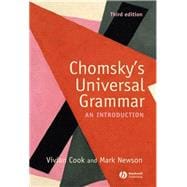
Note: Supplemental materials are not guaranteed with Rental or Used book purchases.
Purchase Benefits
What is included with this book?
Mark Newson is Reader in the Department of English Linguistics at Eötvös Loránd University, Budapest, Hungary.
| Preface to the Third Edition | p. vii |
| The Nature of Universal Grammar | p. 1 |
| The early development of Universal Grammar Theory | p. 2 |
| Relating 'sounds' and 'meanings' | p. 4 |
| The computational system | p. 8 |
| Questions for linguistics | p. 11 |
| General ideas of language | p. 13 |
| Linguistic universals | p. 20 |
| The evidence for Universal Grammar Theory | p. 24 |
| Conclusion | p. 26 |
| Principles, Parameters and Language Acquisition | p. 28 |
| Principles and parameters | p. 28 |
| Language acquisition | p. 45 |
| Structure in the Government/Binding Model | p. 61 |
| The heart of the Government/Binding Model | p. 62 |
| Modules, principles and parameters | p. 62 |
| X-bar Theory in Government and Binding | p. 73 |
| Theta Theory | p. 80 |
| Control Theory and null subjects | p. 86 |
| Further developments in X-bar Theory | p. 100 |
| Summary | p. 118 |
| Movement in Government/Binding Theory | p. 121 |
| An overview of movement | p. 121 |
| Further developments to the theory of movement | p. 133 |
| Bounding, Barriers and Relativized Minimality | p. 139 |
| Case Theory | p. 146 |
| Binding Theory | p. 162 |
| Beyond S-structure and the Empty Category Principle | p. 175 |
| Chomskyan Approaches to Language Acquisition | p. 185 |
| The physical basis for Universal Grammar | p. 185 |
| A language learning model | p. 189 |
| The innateness hypothesis | p. 204 |
| The role of Universal Grammar in learning | p. 205 |
| Complete from the beginning or developing with time? | p. 207 |
| Issues in parameter setting | p. 209 |
| Markedness and language development | p. 215 |
| Second Language Acquisition and Universal Grammar | p. 221 |
| The purity of the monolingual argument | p. 221 |
| Universal bilingualism | p. 222 |
| The multi-competence view | p. 223 |
| The poverty-of-the-stimulus argument and second language acquisition | p. 224 |
| Models and metaphors | p. 228 |
| Hypotheses of the initial second language state | p. 231 |
| The final state of second language acquisition | p. 238 |
| Structure in the Minimalist Program | p. 242 |
| From Government/Binding to the Minimalist Program | p. 243 |
| Basic minimalist concepts | p. 249 |
| Phrase structure in the Minimalist Program | p. 255 |
| Thematic roles and structural positions | p. 262 |
| Adjunction | p. 265 |
| Linear order | p. 268 |
| Movement in the Minimalist Program | p. 271 |
| Functional heads and projections | p. 271 |
| The motivation for movement | p. 275 |
| The nature of movement | p. 279 |
| Overt and covert movement | p. 281 |
| Properties of movement | p. 287 |
| Phases | p. 301 |
| Conclusion | p. 308 |
| References | p. 310 |
| Index | p. 319 |
| Table of Contents provided by Ingram. All Rights Reserved. |
The New copy of this book will include any supplemental materials advertised. Please check the title of the book to determine if it should include any access cards, study guides, lab manuals, CDs, etc.
The Used, Rental and eBook copies of this book are not guaranteed to include any supplemental materials. Typically, only the book itself is included. This is true even if the title states it includes any access cards, study guides, lab manuals, CDs, etc.